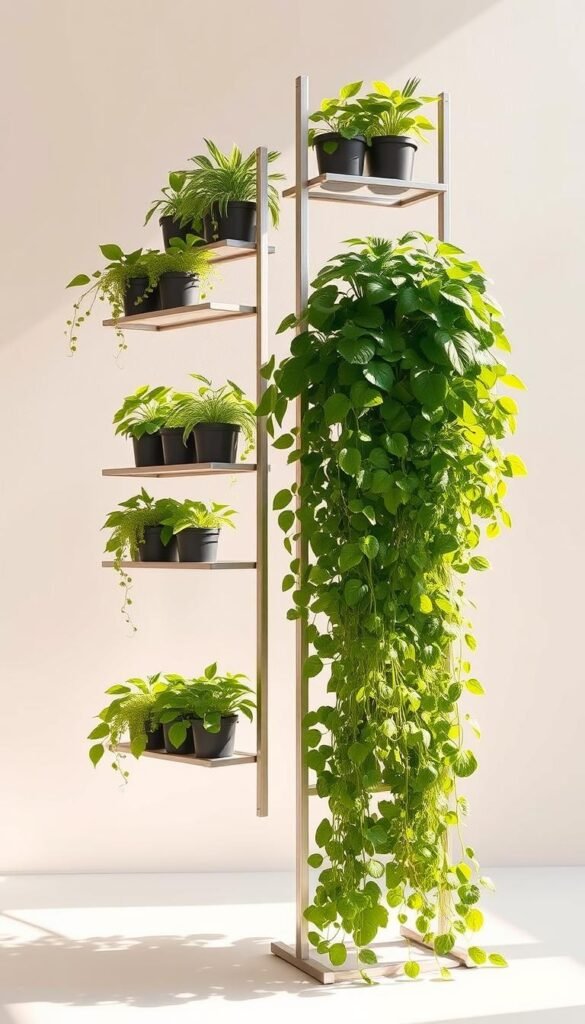Does your urban dwelling or cozy apartment leave little room for greenery? You’re not alone. More plant lovers are discovering how elevated growing systems transform blank walls and narrow corners into thriving ecosystems. By directing growth upward rather than outward, these arrangements let you nurture herbs, flowers, and vegetables without sacrificing precious square footage.
Modern designs blend practicality with style – think stackable pots that create living art installations or floating shelves that showcase your favorite succulents. A recent study found these setups reduce pest issues by 40% compared to traditional methods while boosting herb yields by nearly a third.
The secret lies in smart layering. Wall-mounted panels allow you to mix textures and colors, from trailing ivy to vibrant petunias. Modular towers keep roots organized while maximizing air circulation. Even your kitchen window can host a cascade of fresh basil and thyme.
Beyond saving room, these living displays purify your air and create natural focal points. The right combination of compact planters and sunlight-loving species turns constraints into creative opportunities. Ready to reimagine your walls? Let’s explore how to match your space with the perfect green companions.
Creative Vertical Gardening Ideas for Limited Spaces
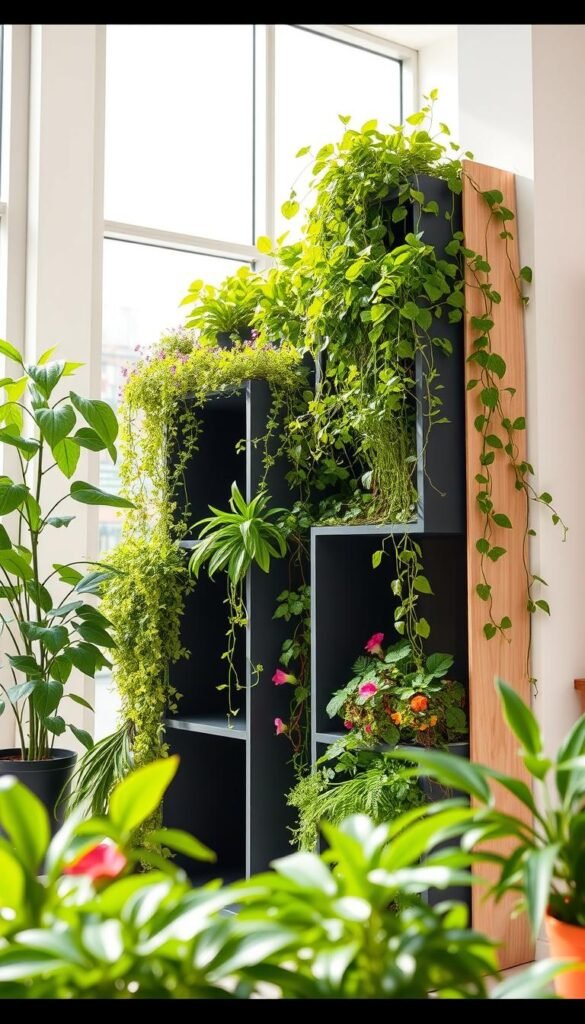
What if your blank walls could burst with life? Urban dwellers are redefining greenery by turning unused surfaces into vibrant plant showcases. With clever arrangements, even the tightest areas become lush retreats.
Stack Wall Planters and Floating Shelves
Stackable planters let you build upward gardens in minutes. Attach interlocking pots to balcony rails or kitchen walls for herbs like mint or oregano. Pair them with floating shelves to mix trailing pothos with compact succulents. Brands like GreenStacks offer modular designs that adapt as your collection grows.
Try staggered shelves above desks or windows. This setup gives each plant ample light while creating visual depth. For a cohesive look, use matching planters in neutral tones.
Ladder Shelves and Corner Displays
Repurpose old ladders into tiered shelving units. Lean them against walls to display air plants, ferns, or flowering orchids at eye level. Corners become prime real estate with triangular wall-mounted racks – perfect for spider plants or ivy that cascade downward.
Rotate seasonal varieties to keep your home fresh year-round. Pair these ideas with practical tips for outdoor living to extend your green aesthetic beyond interior walls.
Space-Saving Solutions: Vertical Container Gardening Racks
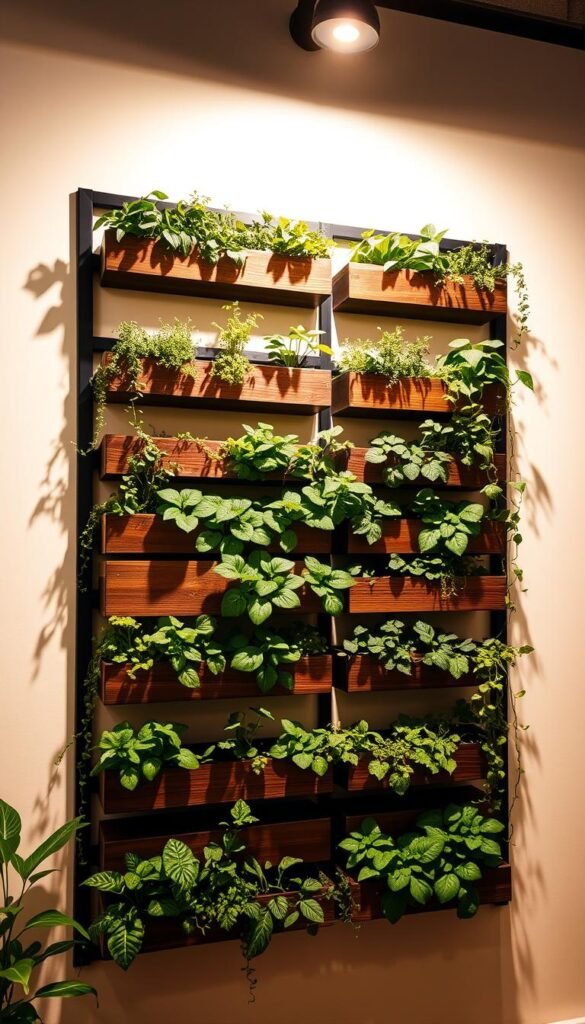
Ever looked at a bare wall and imagined it overflowing with greenery? Advanced setups let you turn these visions into reality while keeping your floors clutter-free. Two standout methods combine artistry with practicality for urban growers.
Mount Vertical Garden Panels for Cascading Greenery
Felt pocket panels make installing living walls simple. Attach them to sturdy surfaces using corrosion-resistant brackets. Plant trailing species like creeping fig or philodendron in upper pockets – they’ll spill downward, hiding the structure as they grow.
For outdoor spaces, try powder-coated metal grids. These support heavier plants like strawberries or cherry tomatoes. Always check weight limits before adding soil and water.
Utilize Pegboards and Modular Shelving for Versatility
Customizable pegboards let you rearrange planters as your collection evolves. Use S-hooks to hang ceramic pots or propagation stations. Pair with cube shelving for mixed displays of herbs and decorative stones.
| Material | Best For | Weight Limit |
|---|---|---|
| Plastic Grid | Small succulents | 8 lbs/sq ft |
| Metal Pegboard | Herb gardens | 15 lbs/sq ft |
| Wooden Shelving | Large ferns | 25 lbs/sq ft |
These systems protect roots from overcrowding while letting you grow a variety of species. Rotate sun-loving specimens to upper tiers and shade-tolerant ones below. Outdoor setups thrive when sealed with weatherproof paint.
Experiment with asymmetrical layouts or color-themed arrangements. Your wall could feature peppermint beside purple basil today, then host blooming orchids next month. The only limit? Your imagination – and maybe your ceiling height!
DIY and Budget-Friendly Vertical Garden Racks
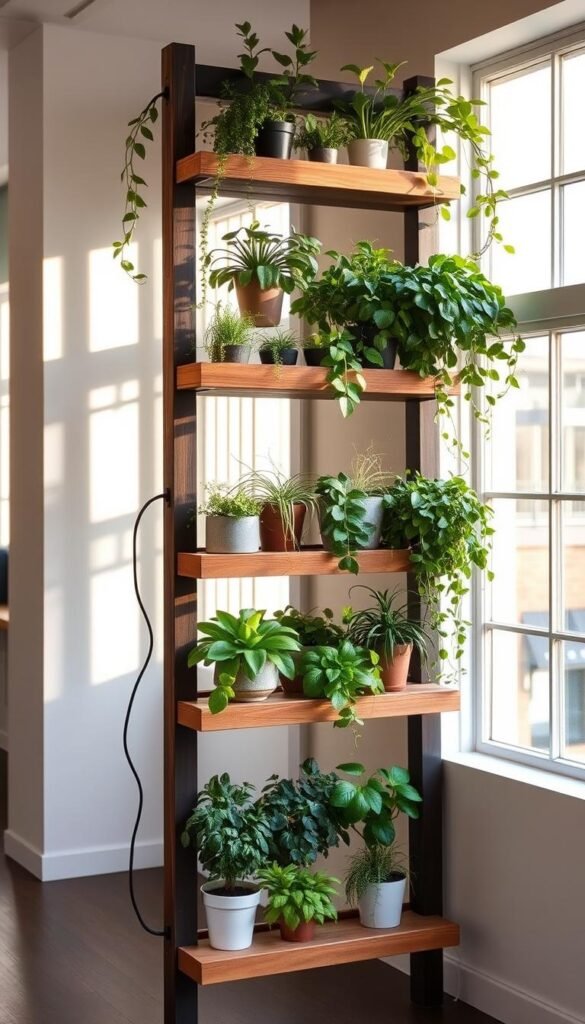
Got unused materials gathering dust? Transform them into living masterpieces without draining your wallet. These inventive approaches turn everyday objects into functional green displays that breathe life into your walls.
Repurpose Pallets and Old Bookshelves
Wooden pallets become instant vertical gardens with minimal effort. Sand the surface, add landscape fabric to create planting pockets, and secure it to a fence or balcony wall. For indoor use, convert old bookshelves into multi-level plant stations by removing shelves and attaching hanging pots.
Construct Floating Cubes and Tiered Wall Planters
Build geometric planters using scrap wood or PVC pipes. Cut 12″x12″ squares, assemble into cube frames, and mount them in staggered patterns. For tiered designs, stack shallow boxes on wall-mounted brackets – perfect for herbs like rosemary and thyme. Always anchor structures to wall studs for safety.
Customize with Hanging Jars and Macramé Plant Holders
Glass jars with wire hockets add whimsy to kitchen herb gardens. Paint mismatched lids for cohesion, or wrap twine around necks for rustic charm. Pair with handmade macramé holders to showcase trailing plants like string-of-pearls. Rotate specimens seasonally for dynamic displays.
These projects reduce waste while letting you grow variety of edibles and ornamentals. Use outdoor-rated sealants for weatherproofing and test weight limits before planting. Your creativity – not your budget – becomes the limiting factor.
Practical Tips to Maximize Your Vertical Space
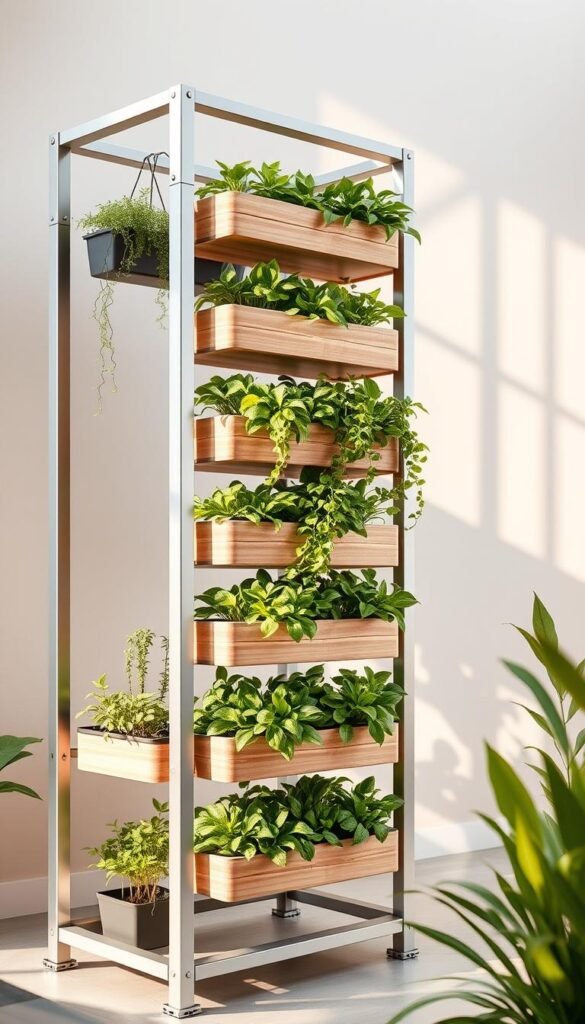
What if your walls could work smarter, not harder? Strategic planning turns every inch into a thriving green zone. Start by pairing plant varieties with their ideal growing conditions – your setup’s success depends on this match.
Smart Pairings: Plants and Planters
Choose lightweight plants with shallow roots for wall-mounted systems. Succulents like hens-and-chicks thrive in dry pockets, while herbs such as basil prefer deeper planters. For tiered shelving, mix trailing ivy with upright snake plants to create depth without overcrowding.
Prioritize materials that suit your environment. Resin planters resist moisture for humid bathrooms, while breathable fabric pockets suit air plants in living rooms. Always check drainage holes – they prevent root rot in compact setups.
Sunlight, Water, and Airflow Essentials
Rotate plants weekly so all sides receive equal light. Use a drip irrigation system or self-watering planters to maintain consistent moisture. Leave 2-3 inches between specimens for proper air circulation, especially in humid climates.
Struggling with brown tips? Increase misting for ferns or relocate heat-sensitive species away from south-facing windows. Outdoor vertical gardens benefit from morning sun exposure and wind-protected mounting spots.
Remember: Your wall’s microclimate differs from floor-level conditions. Test moisture levels with a finger before watering, and adjust your care routine seasonally. With thoughtful placement and quality materials, your living wall becomes a low-maintenance showstopper.
Final Thoughts on Elevating Your Garden Aesthetic
Elevate your surroundings by turning empty vertical spaces into thriving plant displays. From repurposed ladders to modular grids, these setups prove greenery thrives where you least expect it. Vertical gardens don’t just save room—they purify air, spark joy, and let you curate living decor.
Mix textures for visual drama: pair cascading ivy with spiky succulents or cluster aromatic herbs in stackable planters. Lightweight fabric pockets or sleek metal shelves adapt to your style, whether you’re crafting a kitchen herb wall or a balcony oasis. Small tweaks—like rotating sun-loving specimens or adding self-watering systems—yield big results.
Your urban balcony or studio apartment becomes a canvas. Experiment with asymmetrical layouts, color themes, or seasonal rotations. The right plants—think drought-tolerant sedums or peppermint—thrive in compact setups with minimal fuss.
Ready to reimagine your walls? Grab a pegboard, some trailing pothos, and start building upward. Your future garden isn’t on the horizon—it’s right above eye level.

